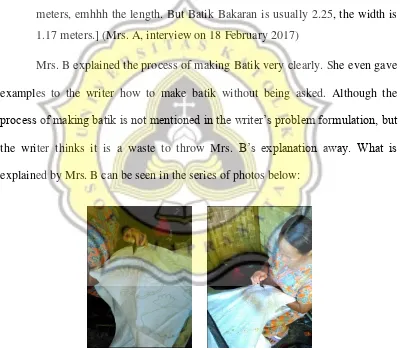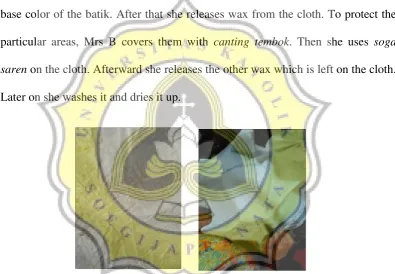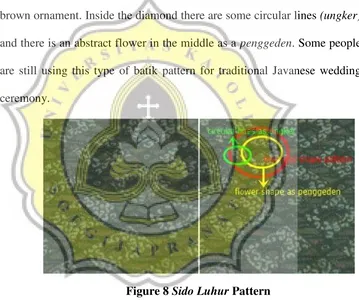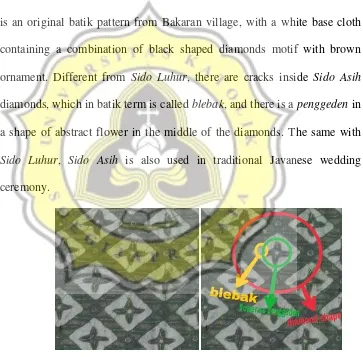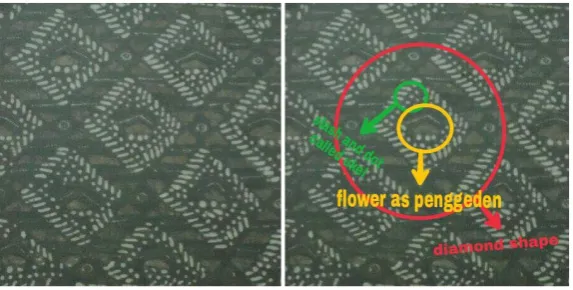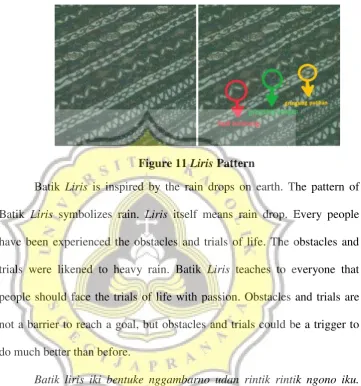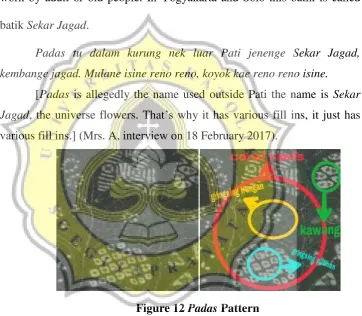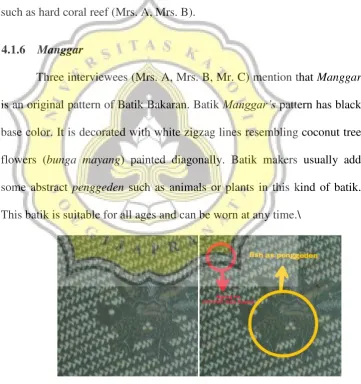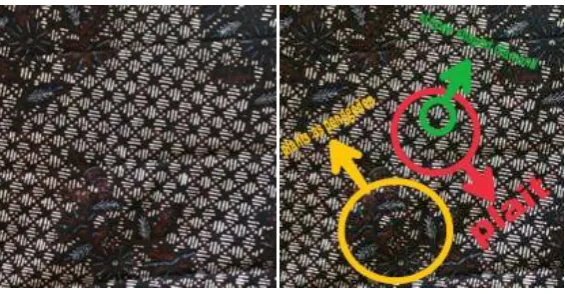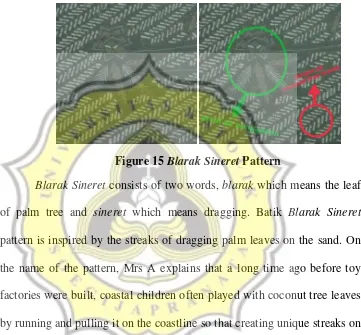21
CHAPTER IV
DATA ANALYSIS AND INTERPRETATION
In this Chapter, the writer will not explain the history of how batik can be
brought to Bakaran, but the writer tries to answer the research questions, which
are: what the patterns of Batik Bakaran are and what the philosophies of Batik
Bakaran’s motifs and patterns are. The writer then presents the category of the
patterns and philosophy of Batik Bakaran’s classic motifs and patterns. The writer
combines the answer of the first research question and the second research
question.
To answer the research questions, the writer interviewed some informants
about the motifs, patterns and philosophies of Batik Bakaran. In finding
informants of the study, it is common to get informants through snowball method.
In the writer’s case, snowball method was also applied with some limitations. As
the interviewees are the merchants who allegedly have no academic background,
they were not easy to approach. In several occasions when the writers asked for
their time to do the interview, they made excuses not to do it by saying that they
were busy preparing for some arts exhibitions or that they had to do some other
business. In the end, the writer felt that the writer was seen as a person who
hindered business done by the interviewees.
After several attempts, the writer tried another method. The writer’s
22
products. The approach proved successful. Three interviewees were willing to talk
to the writer. They were Mrs. A (49 years old), Mrs. B (60 years old), and Mr. C
(56 years old). One of the interviewees, Mr. C substituted his wife, Mrs. C. Mr. C
is a teacher who is more familiar with the idea of doing research so he was more
cooperative to share his experience about Batik Bakaran. While doing his
research, the writer took some pictures about Batik Bakaran from the informants.
The batik patterns and penggeden (a motif that is big in size and considered as
additional pattern) were taken from interviewees’ own collections and
interviewees’ displayed pictures. All of the pictures were taken by the writer’s
camera. Based on the interview data, the writer categorized the motifs and
patterns of Batik Bakaran and its philosophy.
4.1 The Patterns and Philosophy of Batik Bakaran
In this part, the writer mentions the patterns of Batik Bakaran and its
philosophy. To obtain the data of this research, the writer did not only interview
the informants who have better understanding about Batik Bakaran but also used
scholarly research to help him complete the research.
In the beginning of this part, the writer reviewed Indonesian batik. People
commonly believe that Batik is from Solo or Yogyakarta. Interestingly, one of
the informants, Mrs. A, claimed that Indonesian Batik was originally from
Juwana. The informant, Mrs A supported her claim with the historical fact that
there was a big harbor near Bakaran where people from other city and other
23
trading place. As proofs, Mrs A put forward the patterns of Batik Bakaran which
she claimed to be more various than batik from other regions. As mentioned in the
introduction, woman from Bakaran village learnt how to make batik from Nyi
Banowati, a descendent of Majapahit royal family, who wanted Bakaran women
to have useful activity. Earlier, batik was only developed around Bakaran. Later,
Mrs A explained when a King from Keraton Surakarta (Solo Palace) and Keraton
Yogyakarta (Yogyakarta Palace) learnt about Nyi Banowati and Bakaran
women’s batik, the King asked his servants to come to Bakaran village and learnt
how to make batik. When the servants returned to the palaces, they did not only
share their knowledge of making batik to other people who live at the palace, but
they also developed the basic patterns of Bakaran batik. As a result, some of batik
Solo and batik Yogyakarta patterns are similar to Batik Bakaran. The similar
patterns are kawung sari (it is called kawung in Solo and Yogyakarta), ladrang (it
is called parang in Solo and Yogyakarta), padas (it is called sekar jagat in Solo
and Yogyakarta), and some other patterns with similar shape which the informant
claimed to exist but could not be named. In the following years up to now, Batik
Solo and Batik Yogyakarta are more famous than Batik Bakaran because Solo and
Yogyakarta have palaces, the center of culture and governmental power, therefore
they have more access and power to introduce batik to the people.
On the Batik Bakaran itself, based on the interview, Batik Bakaran only
has three colors; there are black, brown and white. In term of size, Batik Bakaran
24
Nek Batik Bakaran, iku awale muk nganggo telung werno, lha wernane
iku ireng, coklat ambek putih. Yowis, nganggo telung werno iku tok jaman
biyen. Nek saiki yo wes macem macem … Nek Batik umume lebare sekitar
2 meteran, ehhh panjange. Tapi nek Batik Bakaran biasane 2.25, lebare
1.17 meteran.
[Batik Bakaran, in the beginning only has three colors, the colors are black, brown and white. That’s it, only use three colors in the past. But today it has more varieties … Batik commonly has the width about 2 meters, emhhh the length. But Batik Bakaran is usually 2.25, the width is
1.17 meters.] (Mrs. A, interview on 18 February 2017)
Mrs. B explained the process of making Batik very clearly. She even gave
examples to the writer how to make batik without being asked. Although the
process of making batik is not mentioned in the writer’s problem formulation, but
the writer thinks it is a waste to throw Mrs. B’s explanation away. What is
explained by Mrs. B can be seen in the series of photos below:
Figure 4 Making Irregular Penggeden & Figure 5 Making Irregular Pattern
Mrs. B said that there was a training to make Batik patterns but she is not
interested in the training. She made batik based on her own method. Mrs. B’s
25
how to master the skill to make Batik Bakaran, sooner or later, the arts of Batik
especially Batik Bakaran will end.
In making Batik Bakaran, firstly she thinks of what she wants to make.
Then she draws the penggeden first and then the patterns. She draws freely on
white cloth to making irregular pattern and penggeden. To make regular pattern
and penggeden, she makes the line to help her to draw neatly. Then she gives the
base color of the batik. After that she releases wax from the cloth. To protect the
particular areas, Mrs B covers them with canting tembok. Then she uses soga
saren on the cloth. Afterward she releases the other wax which is left on the cloth.
Later on she washes it and dries it up.
Figure 6 Making Regular Penggeden & Figure 7 Making Regular Pattern
The writer spent 7 days to interview the informants. Based on the writer’s
interviews with Mrs. A, Mrs. B and Mr. C, in total the writer found twenty one
classic patterns of Batik Bakaran. Those are Sido Luhur, Sido Asih, Sido Mukti,
Liris, Padas, Manggar, Nam Kepang, Blarak Sineret, Gringsing Putihan,
26
Blebak, Ladrang, Gandrung, Kawung Sari, Ungker, and Rawan. In the following
discussion, the writer will describe Batik Bakaran patterns and philosophies.
4.1.1 Sido Luhur
Three Interviewees (Mrs. A, Mrs. B, Mr. C) mention that Sido
Luhur is an original pattern of Batik Bakaran. This pattern is painted on
white cloth. The motif is essentially shaped like a black diamond with
brown ornament. Inside the diamond there are some circular lines (ungker)
and there is an abstract flower in the middle as a penggeden. Some people
are still using this type of batik pattern for traditional Javanese wedding
ceremony.
Figure 8 Sido Luhur Pattern
In English, Sido means “become” and Luhur means “noble.” This
batik contains deep philosophy. Javanese people believe that nobility is
very necessary for everyone. Javanese people’s nobility can be achieved
through their profession, rank and degree. But the most important value of
nobility is from their behavior, manners and way of speaking (Prihandoko,
27
traditional Javanese wedding ceremony. Some people believe that the
nobility degree of the bride and the groom who wear Sido Luhur during
the wedding ceremony will be increased and soon this couple will embrace
full value of nobility (Mrs. A, Interview on 18 February 2017).
4.1.2 Sido Asih
Three interviewees (Mrs. A, Mrs. B, Mr. C) mention that Sido Asih
is an original batik pattern from Bakaran village, with a white base cloth
containing a combination of black shaped diamonds motif with brown
ornament. Different from Sido Luhur, there are cracks inside Sido Asih
diamonds, which in batik term is called blebak, and there is a penggeden in
a shape of abstract flower in the middle of the diamonds. The same with
Sido Luhur, Sido Asih is also used in traditional Javanese wedding
ceremony.
Figure 9 Sido Asih Pattern
Batik Sido Asih has a beautiful philosophy for the brides who wear
this batik in their wedding ceremony. Sido means “become” and Asih
comes from word kasih which means “love.” In short, Sido Asih means
28
(Prihandoko, 2013). The dominant color in this batik is white. The white
color symbolizes purity, love and perfection. The wedding couples who
wear Sido Asih batik during their wedding ceremony believe that they will
have a pure and perfect love. The couples will love and care for each other
more as stated by Mrs A.
Wong jaman biyen iku nek ngomong nek pengantene nganggo kain
Sido Asih jarene bakal tambah saling mencintai.
[The elders said that if the bride and groom worn Sido Asih, they
will love each other more.] (Mrs. A, interview on 18 February 2017).
4.1.3 Sido Mukti
Three interviewees (Mrs. A, Mrs. B, Mr. C) mention that Sido
Mukti is an original pattern of Batik Bakaran.
Batik Bakaran yo Sido Mukti, Sido Luhur, Sido Asih, sembarang
ndengah anane...
[Batik Bakaran are Sido Mukti, Sido Luhur, Sido Asih, and the
others...] (Mrs. B, interview on 12 May 2017)
Batik Sido Mukti is almost similar with batik Sido Luhur and Sido
Asih in which it is painted on a cloth with the basic color of white. The
pattern is a decoration of black shaped diamonds with brown variations.
The difference of Batik Bakaran Sido Mukti from Sido Luhur and Sido
Asih is some short slashes found inside the diamonds, which in Javanese
language called ukel. In the middle of the diamond, there is an abstract
flower as penggeden. Batik Bakaran Sido Mukti is also worn in traditional
29
Figure 10 Sido Mukti Pattern
With regard to its meaning, Sido Mukti consists of two words. Sido
means “become” and Mukti means “prosperous.” Living wealthy and
prosperous is the hope for every person in the world. People believe that
the couples wear this batik pattern when they are married will live
wealthier, prosperous and full of blessings (Prihandoko, 2013). This batik
is commonly worn by a bride in a Javanese wedding ceremony.
4.1.4 Liris
Three interviewees (Mrs. A, Mrs. B, Mr. C) mention that Liris is an
original pattern of Batik Bakaran. This original Batik Bakaran filled with
various patterns of Batik Bakaran. The various patterns of Batik Bakaran
arranged in long diagonal columns cover the entire cloth surface. Patterns
which commonly used are Kedele Kecer, Manggar, Blarak Sineret,
Ungker, and some other original Batik Bakaran’s patterns.
Isine macem macem, koyok gambar iku lho. Ono Kedele Kecer,
ono anu, Manggar, Blarak Sineret, Ungker yo iso.
[It is filled with various types of patterns, the same as the picture.
There is Kedele Kecer, there are something else like Manggar, Blarak
30
This kind of batik is usually worn by people of all ages from young
people to adult. In Solo, this kind of batik called Udan Liris.
Figure 11 Liris Pattern
Batik Liris is inspired by the rain drops on earth. The pattern of
Batik Liris symbolizes rain. Liris itself means rain drop. Every people
have been experienced the obstacles and trials of life. The obstacles and
trials were likened to heavy rain. Batik Liris teaches to everyone that
people should face the trials of life with passion. Obstacles and trials are
not a barrier to reach a goal, but obstacles and trials could be a trigger to
do much better than before.
Batik liris iki bentuke nggambarno udan rintik rintik ngono iku.
Udan iki digambarno cobaan. Mulane iku menungso kudu kuat ngadepi
cobaan.
[Liris represents showering rain. The rain symbolizes trials of life. That’s why people should be strong in facing the trials of life with passion.] (Mrs. A, interview on 18 February 2017).
4.1.5 Padas
Padas is the original classic pattern of Batik Bakaran (Mrs. A, Mrs.
31
contains various patterns used in Batik Bakaran, Batik Padas employs a lot
of coral reef shapes. Each coral reef contains different original patterns of
Batik Bakaran. Patterns which are commonly used to fill the coral reefs are
Kawung Sari, Kedele Kecer, Manggar, Blarak Sineret. If batik Liris is
commonly worn by young people until adult, batik Padas is commonly
worn by adult or old people. In Yogyakarta and Solo this batik is called
batik Sekar Jagad.
Padas tu dalam kurung nek luar Pati jenenge Sekar Jagad,
kembange jagad. Mulane isine reno reno, koyok kae reno reno isine.
[Padas is allegedly the name used outside Pati the name is Sekar
Jagad, the universe flowers. That’s why it has various fill ins, it just has various fill ins.] (Mrs. A, interview on 18 February 2017).
Figure 12 Padas Pattern
Batik Padas is almost similar to batik Sekar Jagad. This batik
contains various patterns in one Batik. This batik is inspired by a story of
Bledug Kuwu (a mud volcano in Grobogan).
Padas iku kan ono ceritane, ono hubungane karo Bledug Kuwu
barang iku. Kan nyondol kan rusak a anu karang-karange, kan ngoten a.
32
[Padas has a story, it is related to Bledug Kuwu. The explosion (of
mud) destroys the coral reefs, right. It (the mud) erupts from the hole. So it
has a story.] (Mr. C, interview on 13 May 2017).
Padas itself means coral reef. Coral reef is hard to be destroyed.
Inside the coral reef on batik Padas, various patterns of Batik Bakaran can
be found. Batik Padas and Sekar Jagad have similar philosophy in that
people should preserve and conserve the diversity that exists around us
such as hard coral reef (Mrs. A, Mrs. B).
4.1.6 Manggar
Three interviewees (Mrs. A, Mrs. B, Mr. C) mention that Manggar
is an original pattern of Batik Bakaran. Batik Manggar’s pattern has black
base color. It is decorated with white zigzag lines resembling coconut tree
flowers (bunga mayang) painted diagonally. Batik makers usually add
some abstract penggeden such as animals or plants in this kind of batik.
This batik is suitable for all ages and can be worn at any time.\
Figure 13 Manggar Pattern
Batik Manggar is inspired by coconut tree flowers.
Manggar, bentuke koyok kembang klopo sing biasane dinggo
33
[Manggar, shaped like coconut tree flower that is usually used on
Javanese wedding. That is manggar] (Mrs. B, interview on 12 May 2017).
Manggar is the Javanese language of coconut tree flowers. Just like
flowers in general, coconut tree flowers has sweet fragrance and it is
beautiful. Coconut tree flowers are usually used for traditional Javanese
wedding ceremony. The flowers are also used as food ingredient in making
gudeg, a Javanese cuisine. Coconut tree has special meaning for Javanese
people. Coconut tree can live everywhere and each part of the tree can be
either consumed or made as tools, none is wasted (Dapur Mamah Nanda,
2015). Therefore, Mrs A and Mrs B say that this pattern teaches people to
live like a coconut tree; to always be useful to anyone, to have inner
beauty, and to be able to adapt easily like coconut flowers (bunga
mayang) (Mrs. A, interview on 18 February 2017 and Mrs. B, interview on
12 May 2017).
4.1.7 Nam Kepang
Nam Kepang is an original pattern of Batik Bakaran (Mrs. A, Mrs.
B). This original Batik Bakaran pattern has black base color decorated
with white stripes shaped like a plait. The striped is shaped like diamonds.
The diamond shaped plaited patterns fill the cloth. Batik makers usually
put plants as penggeden on this batik. Nam Kepang is suitable for all ages
34
Figure 14 Nam Kepang Pattern
Nam Kepang comes from two words. Nam is from nam-naman, it
means weaving and Kepang means plait. On Batik Nam Kepang pattern
there are lines that are formed like a diamond. The diamonds are then
neatly arranged like long plait. Plaiting or weaving required a skill,
diligence and patience. According to Mrs A, this batik is inspired by
villagers who live and get money from crafting.
Ono sing ngayam gedek, ono sing ngayam kupat, yo macem
macem... ngayam iku ndak butuh telaten a? Mulo iku wong urip kudu
telaten.
[Some plaited gedek, some plaited kupat, it varies... plaiting needs patient, is it? That’s why human should be patient.] (Mrs. A, interview on 29 April 2017).
This batik teaches people that we should be more skillful, diligent
and patient in dealing with life.
4.1.8 Blarak Sineret
Blarak Sineret is an original pattern of Batik Bakaran (Mrs. A,
interview on 18 February 2017; Mrs. B, interview on 12 May 2017).
35
coconut tree leaves drawn diagonally filling the cloth surface. Similar to
other batik patterns, this batik also has penggeden. Batik makers usually
put plants as penggeden on this batik pattern. This batik can be worn at
anytime and can be worn by men and women of all ages.
Figure 15 Blarak Sineret Pattern
Blarak Sineret consists of two words, blarak which means the leaf
of palm tree and sineret which means dragging. Batik Blarak Sineret
pattern is inspired by the streaks of dragging palm leaves on the sand. On
the name of the pattern, Mrs A explains that a long time ago before toy
factories were built, coastal children often played with coconut tree leaves
by running and pulling it on the coastline so that creating unique streaks on
the sand. Mrs A further explains that this batik pattern teaches people
about the togetherness of the children who dragged the palm tree leaves
and created unique streaks. In a competition there has not only been
achieved by one person, but there are other person also took a part (Mrs.
36 4.1.9 Gringsing Putihan
Gringsing Putihan and Gringsing Irengan pattern are mentioned by
three interviewees (Mrs. A, Mrs. B, Mr. C) as an original pattern of Batik
Bakaran. Gringsing Putihan has black base color. This original Batik
Bakaran is decorated with small white circles. The batik makers usually
put animals or plants as penggeden on batik Gringsing Putihan to make
this batik more attractive.
Figure 16 Gringsing Putihan Pattern
Pattern Gringsing is the oldest batik pattern. This batik is inspired
by fish scales. The pattern of this batik is shaped like fish scales and
covers the entire surface of this batik. The batik makers usually put
abstract plants or animals as penggeden on this batik. Batik Gringsing
Putihan is dominated with white color because the base color is covered
with white pattern. This pattern is representing of Yang. Yang is masculine,
white, light, young, odd numbers and provides form to all things
(Cartwright, 2012). Gringsing Putihan usually worn by the young people.
Gampangane ngeten mas, Gringsing Putihan ambek Gringsing
37
[To make it easy mas, Gringsing Putihan and Gringsing Irengan
are similar to Yin Yang.] (Mr. C, interview on 13 May 2017)
4.1.10 Gringsing Irengan
Gringsing Irengan has black circles covered the entire surface of
this batik. As Gringsing Putihan, the batik maker also put abstract plants
or animals as penggeden on Gringsing Irengan to make this batik more
attractive.
Figure 17 Gringsing Irengan Pattern
The same with Batik Gringsing Putihan, this batik also has fish
scale shape patterns. The difference between Gringsingan Irengan and
Gringsing Putihan in the previous explanation is that this Gringsingan
Irengan is dominated by black color. This pattern is representing Yin.
Gringsing Putihan and Gringsing Irengan are connected. Those patterns
represent Yin and Yang which complete each other. Yin is feminine, black,
dark, old, even numbers and provides spirit to all things (Cartwright,
38 4.1.11 Limaran
Three interviewees (Mrs. A, Mrs. B, Mr. C) mention that Limaran
is an original pattern of Batik Bakaran. Batik Bakaran Limaran pattern has
black base color with brown horizontal faint diamond. Inside the diamond,
there are two white dots that look striking among abstract flower. Batik
makers usually add plants as penggeden in this batik. This batik can be
worn by anyone at anytime.
Figure 18 Limaran Pattern
Limaran comes from word samar – samar in Javanese, in English
it means vague. There is also another interpretation that Limaran is
delivered from word limar. Limar is a silk cloth that symbolizes luxury
(Juang, 2011). On Batik Bakaran Limaran the brown color looks vague
because it is covered by the black color, while the white color looks
striking. The white dots on Batik Limaran symbolize jewel on the flowers
and add elegance on this batik so that this batik adds elegance to the
39 4.1.12 Magel Ati
Three interviewees (Mrs. A, Mrs. B, Mr. C) mention that Magel Ati
is an original pattern of Batik Bakaran. This original Batik Bakaran pattern
has black base color. This batik contains six white dots formed into a
rectangle which is then made into a square with three other rectangles.
Inside each square there is a white cross that is made from cecekan (small
dots). Batik Bakaran Magel Ati is usually only worn for sad occasions. For
example, this batik is worn during the funeral.
Figure 19 Magel Ati Pattern
Magel Ati comes from words megelke ati which means hurting
heart. This batik is inspired by a form of disobedience at that time. There is
something interesting behind the pattern of Batik Magel Ati. A cross that is
made from cecekan, is a symbol of wrong doing that can still be accepted
by the society at that time. The dots surrounding a cross contain meaning
that young people should not have to survive for themselves alone, if they
survive for themselves alone the result will be bad. The squares that are
made from dots function as boundaries which divide one part to another.
40
A and Mr C (Mrs. A, interview on 29 April 2017; Mr. C, interview on 13
may 2017).
4.1.13 Kedele Kecer
Three interviewees (Mrs. A, Mrs. B, Mr. C) mention that Kedele
Kecer is an original pattern of Batik Bakaran. Batik Kedele Kecer pattern
is very unique. This pattern is only owned by Batik Bakaran. So far there
has been no pattern that resembles the pattern of Kedele Kecer. Kedele
Kecer is very simple. This batik has black basic color with white dots
spread over the surface of the cloth. Batik makers usually put plants or
animals as penggeden on batik Kedele Kecer. There is no particular event
to wear this batik.
Figure 20 Kedele Kecer Pattern
Kedele Kecer is derived from word scattered soybeans. It can be
taken from its name that this batik is inspired by scattered soybeans.
Figure 20 shows the way white dots represented scattered soybeans fulfill
the batik surface. Mrs A and Mrs B explain similarly that Kedele Kecer is
41
Kedele iki panganan sederhana, kan biasane diolah dadi tempe,
tahu... wong jaman biyen mangan tahu tempe iki wes enak ngono go...
[Soybean is a simple food, it can processed to be tempeh, tofu...
people in the past was content with eating tofu and tempeh... (Mrs. A,
interview on 18 February 2017)
The implied prayer for the batik Kedele Kecer wearers is that they
will soon get abundant fortune.
4.1.14 Sekar Baru
Three interviewees (Mrs. A, Mrs. B, Mr. C) mention that Sekar
Baru is an original pattern of Batik Bakaran. Batik Sekar Baru has black
base color. This batik is decorated with penggeden in the shape of a
bouquet or lung - lungan. There are short lines surrounding the penggeden.
Isen isen dots are added to fill the blank space on batik Sekar Baru. This
batik is usually worn as long scarf to carry a baby.
Figure 21 Sekar Baru Pattern
In English Sekar means flower and Baru means new. It means a
beauty that has never been seen before. In Batik Sekar Baru pattern the
penggeden is surrounded by short lines. The lines border the penggeden
42
should protect and educate their children so the children can become
useful for many people (Mrs. B, interview on 12 May 2017).
4.1.15 Kopi Pecah
Kopi Pecah is an original pattern of Batik Bakaran (Mrs. A, Mrs.
B). Batik Kopi Pecah has black base color. It is decorated with white beans
arranged in various positions depending on the creativity of the batik
maker. Usually batik makers add penggeden such as abstract animals or
plants. There is no particular event to wear this batik.
Figure 22 Kopi Pecah Pattern
Batik Kopi Pecah pattern is shaped like coffee beans. The coffee
beans in Batik Kopi Pecah are painted as broken coffee beans. This batik
has a philosophy that something is very hard to break can be broken if it
given continuous exposure (Mrs. A).
4.1.16 Blebak
Three interviewees (Mrs. A, Mrs. B, Mr. C) mention that Blebak is
an original pattern of Batik Bakaran. Batik Blebak is the simplest batik.
43
many types of batik Blebak. For example, Blebak Pring, Blebak Urang,
Blebak Lung and others. The most important thing on batik Blebak is its
penggeden. Batik Blebak comes in many variation depend on its
penggeden. Blebak can be worn at any time.
Figure 23 Blebak Pring Pattern
Batik Blebak is a unique batik. Beside its simplicity, this batik has
various types of penggeden. As mentioned earlier, Batik Blebak has white
base color with black cracks. The black cracks are made from soga saren
(coloring material only used in Batik Bakaran). White color in this batik
means cleanliness, purity and modesty. The black cracks on Batik Blebak
make this batik more attractive. Every penggeden on Batik Blebak has
different philosophy. Today modern patterns of Batik Bakaran have
similar pattern with Batik Blebak but with different base color. The
simplicity of the pattern makes it easier to be added with customized
penggeden that can be an advantage in the market (Mrs. A, interview on
18 February 2017; Mrs. B, interview on 12 May 2017; Mr. C, interview on
44 4.1.17 Ladrang
Three interviewees (Mrs. A, Mrs. B, Mr. C) mention that Ladrang
is an original pattern of Batik Bakaran. Batik Ladrang resembles Batik
Parang from Solo and Yogyakarta. It has black base color with distinctive
white waves. Near the waves there are white dots. Batik Ladrang is
classified as batik keraton because in the past, people who could wear this
batik are only those in the royal courts. But today this batik can be worn by
young and old people.
Figure 24 Ladrang Pattern
Batik Ladrang has similar shape with Batik Parang. Ladrang is
one of the kris cover name (Harsrinuksmo, 2004), while Parang is from
the word pereng which means slope. The word parang is used to name
areas on the coast of Java such as Paranggupito, Parangkusumo and
Parangtritis which supposedly a place used by the Javanese king of
Mataram to meditate until finally he is inspired to design a pattern of batik
that symbolizes the greatness of the king (Kusrianto, 2013). Some people
say that the pattern of Batik Ladrang is like the waves of the sea which has
45
Batik Ladrang pattern is a deformation of an eagle’s shape. Eagle is a
symbol of a person who has a high degree. Parang’s pattern is bigger than
Ladrang’s pattern (Mrs. B, interview on 12 May 2017).
4.1.18 Gandrung
Gandrung is an original pattern of Batik Bakaran (Mrs. A, Mrs. B).
This original Batik Bakaran has white base color with black lines that runs
in every wind direction. In the meeting point of every line, there are black
dots. In order to make this batik more adorable, the batik maker put
abstract animals or plants as penggeden. This batik is suitable for young
people.
Figure 25 Gandrung Pattern
Gandrung means fall in love. According to Mrs. A, this batik
pattern was made by Nyai Banowati when she missed her family and her
lover. The line that crossed out on Batik Gandrung contains a story about
someone who falls in love and waits for the arrival of the lover (Mrs. A,
interview on 18 February 2017). Therefore, this batik is a symbol of sense
46 4.1.19 Kawung Sari
Three interviewees (Mrs. A, Mrs. B, Mr. C) mention that Kawung
Sari is an original pattern of Batik Bakaran. Batik Kawung Sari is called
Batik Kawung in Solo and Yogyakarta. Beside Ladrang, Batik Kawung
Sari is also includes as batik keraton. Batik Bakaran Kawung Sari has
black base color with white oval arranged diagonally. Inside the oval there
are two black dots. Long time ago Batik Kawung Sari was only worn by
the royal servants but today everyone can wear this batik.
Figure 26 Kawung Pattern
Kawung is the Javanese language for sugar palm fruit (kolang
kaling). The form of sugar palm fruit is simplified into four ovals and
arranged in a shape of a cross. It symbolizes the structure of the universe.
The center of the cross of sugar palm fruits on Batik Kawung pattern
symbolizes energy source. The four ovals depict the wind directions which
are east, south, west, and north. The middle of the four sugar palm fruits
depicts human conscience. This batik contains a philosophy that human
being must be able to preserve and unite with the universe. Long time ago
47
should only be used by people who are wise and prudent. Therefore, in
Javanese puppet this batik is only worn by Semar. Semar is known as a
puppet character who is honest, simple, sincere and unconditional
(Pramuditya, 2013). However, today all people can wear Batik Kawung.
Kawung Sari has smaller pattern than Kawung itself (Mrs. A, interview on
18 February 2017; Mrs. B, interview on 12 May 2017).
4.1.20 Ungker
Ungker is an original pattern of Batik Bakaran (Mrs. A, Mrs. B).
Batik Ungker has black base color with white circular (ungker) decorated
the batik surface. Ungker is painted randomly depends on batik maker
creativity. The batik maker usually put penggeden in a shape of abstract
animals or plants to make this batik more interesting.
Figure 27 Ungker Pattern
Ungker means circular. The motif of Batik Ungker is circular as in
a fishhook. This pattern is inspired by fisherman’s fishhook. The main
employment of the coastal area people are as fishermen. The fishhook
48
to one another. It is a symbol of mutual cooperation of coastal people
(Mrs. B, interview on 12 May 2017).
4.1.21 Rawan
Three interviewees (Mrs. A, Mrs. B, Mr. C) mention that Rawan is
an original pattern of Batik Bakaran. Batik Bakaran Rawan has black base
color with white waves close-fittingly covers the surface of the cloth.
Usually the batik makers add animals or plants as penggeden to make this
batik more beautiful. This batik is usually worn by people whose already
has a child. In this batik, it difficult for the writer to find the original batik
Rawan because the batik maker has not yet made it, so the writer attaches
the modified one.
Figure 28 Rawan Pattern (modified)
Rawan is derived from the word swamp. This batik was obtained
when Nyi Ageng meditated in a swamp. This batik pattern resembles quiet
water. Water is something very essential for life. This batik has philosophy
that people can live and overcome all the trials of life with calmness or
49
4.2 Penggeden
As mentioned in Chapter two, Penggeden is the biggest motif on the batik. It
is also called ornament of the batik. Penggeden on Batik Bakaran has abstract
shapes. Usually the batik makers rely on their creativity to adjust the shape of
penggeden with the pattern of the batik. Beside its function as the ornament to
make the batik patterns more attractive, penggeden itself also has philosophy that
must be known by the batik consumer.
Penggeden iku… tergantung… penggeden iku, terdiri dari lung – lungan iso, terus buket iso. Opo iki yo jenenge, manuk opo yo… merak iso, opo neh yo… maceme yo iku leh, urang yo iso penggeden kuwi, bandeng yo iso.
[Penggeden… depends… penggeden consists of lung – lungan, or buket. What is the name, what bird is it… can be peacock (merak), what else then… can be shrimp (urang) , can be milkfish (bandeng).] (Mrs. A, interview on 8
April 2017)
From the interview, the writer finds that Batik Bakaran has five original
penggeden. Those are Lung – Lungan, Buketan, Merak, Urang, and Bandeng.
4.2.1 Lung – Lungan
Lung – lungan is plant-shaped ornament. The other name for lung –
lungan is semen. The word semen is from the word “semi” (bersemi) or in
English it is blossom. As implied in the name, this ornament includes all
parts of the plants. It can be shaped as plant buds, leaves, flowers, short
50
Figure 29 Lung Lungan
The philosophy of lung – lungan itself is plant buds, leaves on the
twigs and the flower of woodbind. This ornament can also be combined
with animals or birds. Lung – lungan can be classified into three which are
those that only contain flowers and leaves, those that contain plants
combined with animals, and those that contain plant combined with lar
(half of garuda’s wings) or sawat (garuda’s wings complete with its tail)
(Kusrianto, 2013). The philosophy of this penggeden is a hope that the life
of the wearer can be growing and thriving to be better (Batik Sekar
Kedhaton, 2014). This penggeden can be used in the entire Batik Bakaran
original pattern except on batik liris and batik padas.
4.2.2 Buketan
The word buketan itself comes from the French bouquet which
means the flower arrangement. This penggeden contains a bunch of
51
Figure 30 Buketan on Sido Mukti Pattern
This ornament is influenced by merchant traders from China who
came to Indonesia. This ornament is growing rapidly on colonialism era,
especially when Dutch came to Indonesia (BatikDan, 2013). According to
Zahir Widadi, buketan ornament contains the philosophy of happiness,
cheerfulness, beauty, tenderness and purity. This penggeden symbolizes a
hope for the wearers to always look cheerful and happy
(radarpekalongan.com, 2017). A lot of original Batik Bakaran patterns use
buketan as penggeden. This penggeden is very popular in modern Batik
Bakaran patterns.
4.2.3 Merak
Merak is a kind of bird, in English merak means peacock. This
kind of bird has beautiful and colorful feather. Penggeden Merak shapes
52
Figure 31 Merak on Gringsing Putihan Pattern
According to Adi Kusrianto, merak ornament is used to symbolize
holiness, sanctity, and the image of the world above, because peacock is
the transportation of the gods (Kusrianto, 2013). This penggeden can be
used in every original Batik Bakaran except on batik liris and batik padas
by adjusting the patterns based on the creativity of the batik maker.
4.2.4 Urang
In English Urang means shrimp. Shrimp is very close to Bakaran
people’s life. Some people in Bakaran have shrimp ponds. In Bakaran,
shrimps are usually processed into shrimp paste. The taste and quality of
Bakaran’s shrimp paste is better than the other regional shrimp paste
53
Figure 32 Urang on Kedele Kecer Pattern
Shrimp can be one of penggeden of original Batik Bakaran because
it is close to the villager’s life. It symbolizes pleasure and helps the
villager’s economy. Penggeden urang is usually combined with kipas
(fan), people usually called it kipas urang (Mrs. B, interview on 12 May
2017).
4.2.5 Bandeng
Bandeng is a kind of fish, in English it is called milkfish. Beside
shrimp, bandeng is also very popular in Juwana. Many Bakaran people
also cultivate bandeng on their fishponds. They usually process it into
bandeng presto (soft spines milkfish). Besides processing it into bandeng
presto, bandeng can also be processed into delicious foods which are
54
Figure 33 Bandeng on Manggar Pattern
Processing bandeng into food takes time. If the bandeng is not
properly processed, it will leave many tiny bones hard so it is difficult to
enjoy the eating. If it is processed to long, the fish is also not good because
it is too soft and the taste is not delicious anymore. It is similar to people’s
lives, if life is not managed properly, people will face discomfort in their
lives (Roestandi, 2011). The same with Urang (shrimp), Bandeng
(milkfish) is close to the villager’s life, and this penggeden can also be
combined with kipas (fan) (Mrs. B, interview on 12 May 2017). This
penggeden can also be used in every original Batik Bakaran except on
